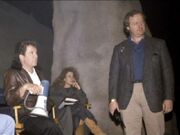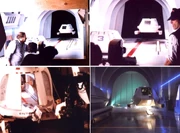Template:Realworld Associates and Ferren was the visual effects company that was contracted to provide the visual effects for Star Trek V: The Final Frontier. Founded in 1978 by its namesake, cinematographer Bran Ferren, [1] and originally located in Long Island, New York City, [2] the company at first started out as a a research house for developing cinematographic equipment and techniques. Very soon afterwards it started to produce visual effects, first for commercials, and later on for motion picture productions as well, with Tempest (1982) its first motion picture credit.
In 1988, the company was sought out by the producers of Star Trek to produce the visual effects for the upcoming feature. As to why the company, by then located in Hoboken, New Jersey (though still maintaining a subsidiary facility in New York City), was chosen, William Shatner, a bit derogatory perhaps as far as ILM was concerned, has elaborated, "Having begun our search for magic at ILM, we were dismayed to find that most of that firm's best technicians, the A team, were already hard at work on the Steven Spielberg/Lucas collaboration Indiana Jones and the Last Crusade. At the same time, a good portion of the B team were putting together the effects for Ghostbusters II. We knew that the best ILM could offer simply wasn't their best, and for that reason, we tested the water by asking a number of companies all over Hollywood to audition for the job on Star Trek IV, fronting each of them $10,000 and asking that they do their best to create a striking and unusual image of God. We found our winner in... Hoboken, New Jersey." (Star Trek Movie Memories, pp. 298-300)

Ferren (r) with Shatner on the Sha Ka Ree set

Associate's film crew filming the landing sequence of the Galileo
However, years later, in 2010, Executive Producer Ralph Winter candidly admitted that, as far as he was concerned, other considerations also came into play, "We felt like we got taken advantage of by ILM and so we shopped to go to other places. We found a guy in New York, Bran Ferren, who had a pretty good approach to doing the effects, but ultimately they were horrible." [3] Winter's assessment of Ferren's "good approach", no doubt reinforced by the fact that the company earned a Academy Award nomination in the category "Best Effects, Visual Effects" the previous year for Little Shop of Horrors (1986), was also impressed upon would-be director Shatner. Shatner recalled, "Traveling to Ferren's studio, he almost immediately dispensed with the small talk and dragged us into his workshop. Once inside, he showed us that without complicated opticals, lenses, or computer-generated graphics, he could conjure up effects that were truly magical. With a small centrifuge whooshing amid a large aquarium-style tank, a whirlpool quickly developed, ultimately running almost perpendicularly through the center of the redesigned guppy house. Now adding a few chemicals to the tank while smiling broadly, not unlike the Sorcerer's Apprentice, Ferren clicked on a few lights, creating a blinding column of light, and held us enthralled in his low-tech wizardry. We signed him on the spot." (Star Trek Movie Memories, p. 300) Signed on to do all the visual effects for the feature, what Shatner had witnessed was pretty much the technique Ferren would use in creating the Great Barrier effect, as later featured in the movie.
Eventually, the film proved to be a less than cordially received outing in the Star Trek film series for various reasons. Part of the reasons were the visual effects of which Winters commented, "And, unfortunately I almost killed the franchise in terms of the visual effects. (...) And the combination of a story that was not working, it just wasn't commercial, the effects were terrible – we almost killed the franchise, it almost died." [4] As far as the "God" sequence was concerned, Ferren conceded in 1990, "The FX turned to out to be very disappointing, and this was a movie that we really needed them to put us over the top story-wise. Especially at the climax with the horde of rock gargoyles. You don't ever like to say that because you don't want to think that a movie is dependent on special FX. Certainly, Star Trek is the kind of thing where the FX play less of a role than the characters and the story, but I think that the story we were telling this time, at least at the movie's end, very much needed unique and convincing special FX to make those story points work. Those FX don't quite deliver, and in some cases, it looked a little shoddy and ludicrous." [5]
Apart from this, Associates and Ferren encountered many more problems during the production. Organized as a flexible organization with a core of about forty staffers, [6] Ferren was forced to subcontract a large number of additional personnel and companies, as the production proved to be the most effects-laden project the company had ever embarked upon. Among the subcontractors were Gregory Jein, Inc., to help out Associates' own model shop, as well as Peter Wallach Enterprises for the blue-screen photography, with which Ferren's company had no experience, due to his aversion to the technique. (Cinefex, issue 42, p. 51; American Cinematographer, July 1989, p. 76) Another serious setback was the vandalism performed on the Enterprise model that had to be addressed at great expense. All these additional problems contributed to the visual effects as being perceived sub-par, especially in comparison to ILM.
Apart from the above-mentioned productions, Associates' only other visual effects motion picture credits were Hannah and Her Sisters (1986), Funny (1989), Making Mr. Right (1987), The Untouchables (1987), and Second Sight (1989).
Associates and Ferren ceased its existence in October 1993, when it was absorbed into Walt Disney Imagineering, as Ferren took on a position as Senior Vice President – Creative Technology in that company. [7]
Staff
- Lou Bunin - Stop Motion Animator
- Don Canfield - Motion Control Programmer
- Phil Cullum
- John Dima
- John Eaves - Model Maker (subcontractor, uncredited)
- Bran Ferren - CEO/Visual Effects Supervisor
- John Gaeta
- Jim Gratson
- Don Howard
- Gregory Jein - Model Maker (subcontractor, uncredited)
- Mike Joyce
- Michael Kellough
- Steve Kirshoff - Pyrotechnics Expert
- Andrew Laszlo - Cinematographer (subcontractor)
- Bob Lyons - Motion Control Programmer
- David V. Mei - Lead Modeler
- Daniel Nauke
- Mike Tabacco - Chief Modelmaker
- Thomas Quinn
- Edward Rapp - Effects Producer
- Jack Riedel - Motion Control Programmer
- Warren Riggs - Model Maker
- Robert Rohwolt - Senior Optical Photographer
- David Sharp - Model Shop Supervisor
- Michael Sullivan - Model Photography Designer
- Susan Tremblay - Animation Supervisor
- Kenneth Walker - Effects Engineer
- Peter Wallach - Motion Control Expert (subcontractor)
- Dana White - Model Maker (subcontractor, uncredited)
- Mike Woods - Effects Supervisor
Further reading
- "Cinematography at the Limits of the Universe"; "Effects for Trek V Explore Uncharted Territory", Ron Magid, American Cinematographer, July 1989, pp. 58-74; 76-92
- "Sharing the Pain", Paul Mandell, Cinefex, issue 42, May 1990, pp. 44-68
External link
- Template:IMDb-link
